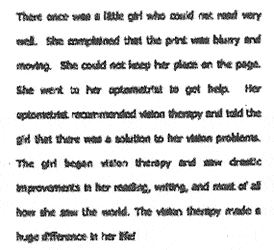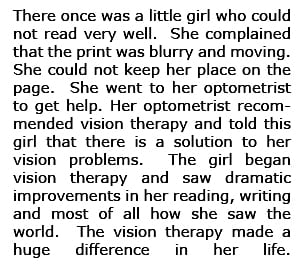Vision Processing
Does your child show characteristics of reading visual problems?
What is Visual and Auditory Processing?
Visual and auditory processing are the processes of recognizing and interpreting information taken in through the senses of sight and sound. A visual processing or perceptual disorder refers to a hindered ability to make sense of information taken in through the eyes. This is different from problems involving sight or sharpness of vision. Difficulties with visual processing affect how visual information is interpreted or processed by the brain. Below is a representation of what text might look like if you had a Learning Related Vision Problem.
The following displays the various ways in which text may appear to someone with reading difficulties and how the text should be seen under normal vision circumstances.
What Does a Visual Processing Problem Look like?
Visual Processing Problems

Normal visual Processing

Physical Clues
- Red, sore, or itchy eyes.
- Jerky eye movements, one eye turns in or out.
- Squinting, eye rubbing or excessive blinking.
- Blurred or double vision.
- Headaches, dizziness or nausea after reading.
- Head tilting, closing or blocking one eye when reading.
Performance Clues
- Avoidance of near-point work.
- Frequent loss of place.
- Omission, insertion, or rereading of letters/words.
- Confuses similar looking words.
- Fails to recognize the same word in the next sentence.
Secondary Symptoms
- Functions at a high level in every activity but schoolwork.
- Low self-esteem, poor self-image.
- Temper flare-ups, aggressiveness.
- Frequent crying.
- Short attention span.
- Irritability.
- Daydreaming.
Labeled
- Lazy.
- Dyslexic.
- Attention deficit disorder.
- Slow learner.
- Behavioral problem.
- Juvenile delinquent.
- Working below potential.
Have you heard of this before?
“We were told our child has 20/20 eyesight. The teacher thought she just wasn’t trying hard enough.”
An eight-year-old child passed the 20/20 eye chart test with flying colors yet she saw letters move around on the page, words, and letters disappear and print go in and out of focus. When asked if she had ever told her parents or teacher that this was happening, she replied was, “No, I thought books did that to everyone.”
Children with learning related vision problems rarely report symptoms. They think everyone sees the same as they do.
Vision is more than 20/20 eyesight. It is a complex process involving over 20 visual abilities and more than 65% of all of the pathways to the brain. Nearly 80% of what a child perceives, comprehends and remembers depends on the efficiency of the visual system.
A child can’t learn to read when the words get jumbled up on the page and he/she can’t remember or make sense of what was just read.
Even though this is an extensive list of symptoms, it does not cover all the possible complications associated with neurological processing difficulties. For more information and resources please contact any of these organizations:
- The College of Optometrists in Vision Development (COVD)
- Optometric Extension Program Foundation (OEP Foundation)
- Neuro-Optometric Rehabilitation Association (Nora)

